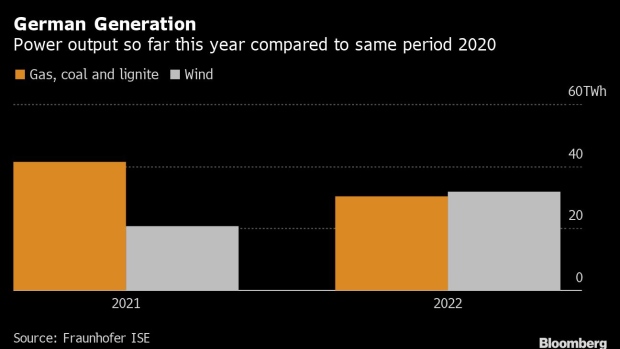Feb 21, 2022
Wind Power Is Back in Europe as Storms Spur Record Output
, Bloomberg News

(Bloomberg) -- Wind power is making a comeback in Europe as three named stormed battered the region in the past week, helping ease reliance on fossil fuels just as tensions over Ukraine are running high.
Turbines in the European Union generated a record 14.9 terawatt-hours of electricity last week, with Germany producing the most wind power ever on Sunday, according to data from research institute Fraunhofer ISE. The spike came as Dudley, Eunice and Franklin -- as the storms were known in the U.K. -- cut power to millions of homes and disrupted air travel across the region.
The surge in wind output is a relief for Europe, which is grappling with an energy crunch and concerns that tensions between the west and Russia over Ukraine could further crimp natural gas supplies. It also represents a turnaround from last year, when low wind speeds forced European utilities to burn coal -- the dirtiest fossil fuel -- to keep the lights on.
“The main increase is due to the weather conditions, with strong winds this year,” said Bruno Burger, head of the advanced technology and devices department at Germany’s Fraunhofer ISE. An increase in the number of wind turbines installed also “helped also a bit,” he said.
Wind power output in the European Union climbed 26% this year to about 84 terawatt-hours, while the amount of electricity generated by gas, coal and lignite gained just 0.3% to almost 141 terawatt-hours, Fraunhofer ISE data showed. The shift has been so pronounced in Germany that the nation produced more power from wind this year than from fossil fuels.
More wind power will help ease tightness in the market, already coping with several nuclear outages in France and concerns about a disruptions to gas flows from Russia. About a third of the shipments from Europe’s top supplier typically flow through pipelines cross Ukraine.
Germany has installed 1.5 gigawatts of new wind capacity since 2020, according to Fraunhofer ISE. As more turbines start operating, periods of stormy weather will help displace fossil fuel plants, which have higher production costs. Installed wind power capacity in Germany is expected to grow 45% to 91 gigawatt-hours by the end of this decade, according to BloombergNEF.
READ: Germany’s Wind Boom Won’t Ease Its Demand for Gas: BNEF
The closing of four gigwatts of nuclear capacity in Germany at the end of last year has also helped drive the share of wind in Germany’s total electricity generation to 46% this month, BloombergNEF said in report.
The increase in wind power is yet to significantly lower the cost of electricity in Germany, one of the highest in Europe. Average daily costs of almost 148 euros a megawatt-hour this year is almost three times higher than in the same period last year. That’s because coal and gas are still needed to meet demand, setting the marginal price for power.
©2022 Bloomberg L.P.


